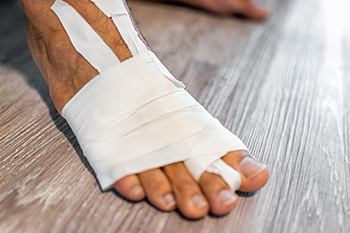What Is Turf Toe?
 Turf toe is a sports-related injury commonly associated with athletes who play on artificial turf. It is a sprain that occurs when the big toe joint is bent upwards at a significant angle. Turf toe injuries are frequent in sports that involve rapid starts, stops, and pivots, such as football, soccer, or basketball. Additionally, the hard surface of artificial turf increases the likelihood of turf toe, compared to natural grass, because it gives less cushioning for sudden movements. Symptoms of turf toe include pain, swelling, and limited joint movement at the base of the big toe. Rest and elevation are important for mild injuries, whereas severe cases may require immobilization of the toe with taping, stiff-soled footwear, or even a walking boot. Athletes benefit from wearing appropriate footwear that offers sufficient support to minimize the risk of turf toe and other similar injuries. If you suspect a turf toe injury, it is suggested that you make an appointment with a podiatrist for diagnosis and treatment options.
Turf toe is a sports-related injury commonly associated with athletes who play on artificial turf. It is a sprain that occurs when the big toe joint is bent upwards at a significant angle. Turf toe injuries are frequent in sports that involve rapid starts, stops, and pivots, such as football, soccer, or basketball. Additionally, the hard surface of artificial turf increases the likelihood of turf toe, compared to natural grass, because it gives less cushioning for sudden movements. Symptoms of turf toe include pain, swelling, and limited joint movement at the base of the big toe. Rest and elevation are important for mild injuries, whereas severe cases may require immobilization of the toe with taping, stiff-soled footwear, or even a walking boot. Athletes benefit from wearing appropriate footwear that offers sufficient support to minimize the risk of turf toe and other similar injuries. If you suspect a turf toe injury, it is suggested that you make an appointment with a podiatrist for diagnosis and treatment options.
Toe pain can disrupt your daily activities. If you have any concerns, contact one of our doctors of New England Foot & Ankle . Our doctors can provide the care you need to keep you pain-free and on your feet.
What Causes Toe Pain?
Most severe toe pain is caused due to a sports injury, trauma from dropping something heavy on the toe, or bumping into something rigid. Other problems can develop over time for various reasons.
Toe pain can be caused by one or more ailments. The most common include:
- Trauma
- Sports injury
- Wearing shoes that are too tight
- Arthritis
- Gout
- Corns and calluses
- Hammertoe
- Bunions
- Blisters
- Ingrown toenails
- Sprains
- Fractures (broken bones)
- Dislocations
When to See a Podiatrist
- Severe pain
- Persistent pain that lasts more than a week
- Signs of infection
- Continued swelling
- Pain that prevents walking
Diagnosis
In many cases the cause of toe pain is obvious, but in others, a podiatrist may want to use more advanced methods to determine the problem. These can range from simple visual inspections and sensation tests to X-rays and MRI scans. Prior medical history, family medical history, and any recent physical traumatic events will all be taken into consideration for a proper diagnosis.
Treatment
Treatments for toe pain and injuries vary and may include shoe inserts, padding, taping, medicines, injections, and in some cases, surgery. If you believe that you have broken a toe, please see a podiatrist as soon as possible.
If you have any questions please feel free to contact our offices located in Wakefield, MA, Nashua and Derry, NH . We offer the newest diagnostic tools and technology to treat your foot and ankle needs.
